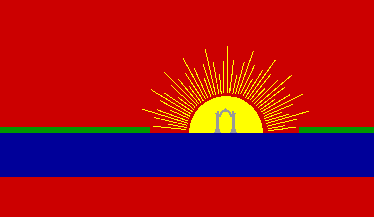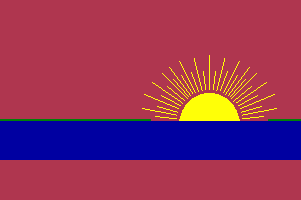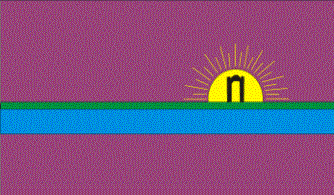
image by Raul Jesus Orta Pardo, 15 February 2007

Last modified: 2007-06-23 by dov gutterman
Keywords: carabobo | venezuela | arch | sun | sugar cane | coffee |
Links: FOTW homepage |
search |
disclaimer and copyright |
write us |
mirrors

image by Raul Jesus Orta Pardo, 15 February 2007
See also:
Municipalities (Capitals):
Other sites:
According to reports at <www.eluniversal.com>
[note: the photo shows a flag of the State of Aragua] and <www.el-carabobeno.com>,
Carabobo State is in a process of changing its flag. See also
project for a flag at <colombia.indymedia.org>.
Valentin Poposki, 5 April 2006
The New Flag - Attributes and Semiology: Consists on a field
with approximate ratio 2:3; this is, a square and half of length,
divided in four horizontal stripes with different sizes. The
purple stripe symbolizes the blood spilled by our Liberators on
the field of the Battle of Carabobo, summit fact that sealed the
Independence of Venezuela. The green stripe represent the immense
capacity of agricultural and cattle production of the Carabobo
State, as well as their enormous ecological potential,
represented in their western valleys, their prairies and their
mountains. The sky blue stripe remembers the access to the sea
and the universality character of the federal entity. The orange
nascent sun, off centered to the fly of the flag separating the
green stripe and arising from the blue one, symbolizes the light
that conquers the shades illuminating the steps that guide to all
Carabobenians toward their integral development. The Victorious
Arch of Carabobo in gray inserts on the sun and seated on the sky
blue stripe symbolizes the same essence of the identity of the
inhabitants of the region and commemorates the great facts which
had place on its floor and consolidated the Venezuelan
nationality.
- Historical Synthesis: The author of the first Carabobenian flag
was Miss Conchita Zamora Mata who won the contest organized to
design the flag in 1995. Later and as a product of another
contest organized by the Government of the Stae, it was presented
1500 projects of whose was selected six presented by children
which serves to assemble the new flag that in practice derives
from the previous design. The color of the solar circle was
defined taking into account an observation of Governor Luis
Acosta Carlez and the flag was instituted on March 12th, 2006.
Sources: Web
Site Government of Carabobo State, Diario
El Carabobeño, (Daily el Carabobeño).
The Coat of Arms and Anthem are the same.
Raul Jesus Orta Pardo, 15 February 2007
The Governor officially approved the change of the flag on 12
March 2006.
According to "Diario
El Carabobeño", 12 March 2006, the Secretary of
Education Sarina Cascone presented the new flag of the State of
Carabobo in the Fine Arts School "Arturo Michelena",
Valencia. Some 1,500 proposals were designed by students and
children from the State of Carabobo. Among them, the winners are
Jeniffer Lugo (Juan José Mora), Reidy Sandoval (Montalbán),
Hermes Castellanos (Montalbán), Eucaris Torres (Valencia), Luis
Zambrano (Bejuma) and Chantal Castro (aged 4!). The new flag was
designed on the basis of these winning proposals. The new flag
has a larger upper purple stripe whereas the lower purple stripe
has been reduced. The Arch of Carabobo has been made larger and
the sun yellow rays are curved. The colour of the sun center was
not specified; the Governor said on TV it could be orange, a
shade that was eventually retained.
The current flag of the State of Carabobo is shown
and described
on the State of Carabobo official website: Purple represents the
blood shed by the liberators during the battle of Carabobo; blue
represents the access to the sea, which symbolizes Carabobo's
universality. The sun stresses that the flag represents the light
dominating the darkness; the Arch of Carabobo, commemorating the
battle that strengthened the national independence, is part of
the essence of Carabobo. The thin green stripe represents the
agricultural and ecological potential of the State of Carabobo.
A photography on the real flag can be seen on the State of
Carabobo official website, in the Governor's
photo gallery, third row, first picture .
Ivan Sache, 29 April 2007

image by Guillermo Aveledo, 3 October 1999
The flag has, in the middle of the sun, the grey Arch of
Carabobo, the monument for Venezuela's independence main battle
(Battle of Carabobo, 24-06-1821). We did not obtain full
independance through this, as it is often said: Puerto Cabello's
siege, where we defeated the last units of the Metropolitan
Spanish Army, was a year later. In any case, the Carabobo Arch
stands at the height of the monument to this battle, and to the
heroes of that day. It was built in 1821.
Source: 1981 edition of "Los Simbolos Sagrados de
la Nacion Venezolana", by Francisco A. Vargas
Guillermo Aveledo, 3 October 1999
The Carabobo State's Flag - Attributes and Meaning:
Carabobo is one of the northern, coaster and central states of
Venezuela and its flag consists of five horizontal stripes with
different sizes. The purple red fringes symbolizes the blood
spilled by our Liberators on the field of the Battle of Carabobo,
summit fact that sealed the Independence of Venezuela. The green
fringes represent the immense capacity of agricultural and cattle
production of the Carabobo State, as well as their enormous
ecological potential, represented in their western valleys, their
prairies and their mountains. The blue fringe remembers the
access to the sea and the universality character of the federal
entity. The yellow nascent sun, located between the center and
the floating one of the flag separating the green fringes and
arising of the blue fringe, it symbolizes the light that conquers
the shades illuminating the steps that guide to all the
Carabobenians toward their integral development. The Victorious
Arch of Carabobo in gray inserts in the sun and seated on the
blue fringe symbolizes the same essence of the identity of the
inhabitants of the region and it commemorates the great gest
which had place on its floor and consolidated the Venezuelan
nationality.
The author of the Aragua State Flag is Miss Conchita Zamora Mota
who won the concourse which was organized to design the flag in
1995.
Raul Jesus Orta Pardo, 5 September 2000
A similiar but different flag of the state found at <www.carabobo.org>.
I notice the green line stretches across the whole length
compared to the image above.
J.J.Andersson, 25 March 2002
In relation to that report, we can say that the image above is
trustworthy and takes like source an Official and Special
Bulletin of the Secretary of Education of the Carabobo State sent
to us by the Mrs. Aura of Rodríguez, General Director of the
Carabobo State Government on July 28th, 1999.
Raul Jesus Orta Pardo, 27 March 2002
carab.gif)
image by Raul Jesus Orta Pardo, 19 September 2000
The Carabobo State Coat of Arms - Attributes and Meaning:
The name of the Carabobo State is an homage to the Battle which
sealed the Independence of Venezuela in 1821. The Carabobo State
Coat of Arms presents an embroidered and barred field divided per
fess in two quarters. The first quarter, above, represents a
fortress surrounded by the sea and assaulted by infantry troops
and of chivalry that remembers the Taking of Puerto Cabello,
(Hair Port) one of the principal Venezuelan harbors on November
8th, 1823. The second quarter, below, shows a semblance of the
Field of Carabobo, with a osugar cane plant at the dexter and
another one of coffee to the sinister: the two more important
agricultural products of the region. On the center, an attic and
silvered column reminds that was ordered to erect by the Congress
of Cucuta to commemorate the victory, which the Patriot Army
reached in the Battle of Carabobo on June 24th, 1821, date
inscribed on the pedestal. The bar of gold that divides the field
in two quarters charges the Latin motto OCASSUS SERVITUTIS
(Decline of the Servitude) for remember which with the Battle of
Carabobo and the Taking of Puerto Cabello was sealed forever the
emancipation of Venezuela. The nascent sun over the Shield how
timmer, symbolizes the birth of the Republic and the Cornucopias
that appear to its flanks, reminds the abundance of the
Carabobenian ground. This coat of arms entered in validity by
means of the "Law of the Coat of Arms and Seal of the
Carabobo State" on December 12th, 1905.
Sources:
- Los Si'mbolos Sagrados de la Nacio'n Venezolana (The Sacred
Symbols of the Venezuelan Nation) by Francisco Alejandro Vargas,
1981.
- Special Bulletin of the Secretary of Education of the Carabobo
State sent by the Mrs. Aura of Rodri'guez, General Director of
the Carabobo State Government on July 28th, 1999.
Raul Jesus Orta Pardo, 19 September 2000
1) 
image from <www.geocities.com/SiliconValley/Hills/8517/entrar.htm>,
located by Dov Gutterman, 14 August 1999
In this image , the symbol within the sun is missing.
Jaume Ollé, 15 August 1999
2) 
image by Pablo Acosta Ríos, 3 October 2002
Carabobo flag at <www.epicentro.com.ve>
appears with purple background.
Pablo Acosta Ríos, 3 October 2002